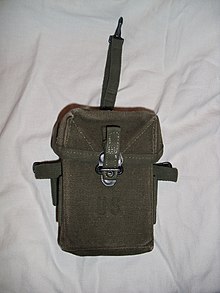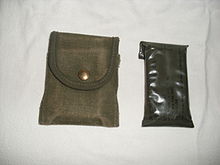M1956
The M1956 Load-Carrying Equipment (carrying equipment) is a system of bags and straps that was used by the armed forces of the United States to carry personal equipment during the Vietnam War, among others .
history
In 1950, the US Army scrutinized its equipment. Quartermaster Research and Engineering Laboratories conducted tests under realistic simulated combat conditions; as a result, new load limits for the individual soldier were set in 1952. This load was 45 lbs. (20.5 kg) and consisted of a combat load of 20 (9.1 kg) and a maintenance load of 25 lbs. (11.4) together. The combat load consisted of the personal weapon with ammunition and vital equipment, which was carried by means of a cartridge belt and the M1945 Combat Pack. The maintenance burden consisted of additional items carried in the M1945 Cargo Pack and the blanket roll.
1954 began the development of new equipment. The cartridge belt should be replaced with a multipurpose belt. Since the equipment fastened with the wire hooks of the M1910 equipment threw around while running, a vertically movable metal bar (Slide Keeper) was developed with which equipment was securely attached to the belt.
In 1957 the new carrying equipment was introduced as the M1956. The introduction took place together with that of the new M14 rifle. In 1967 an improved version made of nylon was introduced, but it never completely replaced the M1956. In 1974, the M1956 carrying equipment was replaced by the ALICE (All-purpose Lightweight Individual Carrying Equipment), but was still in use at times for training units.
description
The components of the M1956 carrying equipment are made of dark olive green cotton fabric. The metal parts are made of steel or brass and have been blackened.
Components
Belt, individual, equipment M1956
The basic element of the M1956 carrying equipment is the perforated coupling . It is made of cotton fabric and has three rows of metal eyelets. The middle row is used to adjust the length, the upper and lower rows for attaching equipment. The length of the coupling is adjustable at both ends; the ends are folded inwards and have hooks that engage the metal eyelets in the middle rows. The belt is available in the lengths "Medium" (adjustable from 69 to 112 cm) and "Long" (adjustable from 113 to 142 cm). The length has been chosen so generously that the belt can also be closed over thick winter clothing.
Pouch, small arms ammunition, universal
The ammunition pouch of the M1956 carrying equipment is dimensioned in such a way that the ammunition of the handguns still in use by the US Army at the point of introduction can be accommodated in it. On the side of the pocket there are tabs into which the spoon safety device for hand grenades can be attached; In addition, the hand grenades can be secured with short straps with press studs. On the back there are two slide keepers and an adjustable strap with a snap fastener at the end, with which the bag can be connected to the suspenders. Eight loading frames for the M1 rifle , two magazines for the M1918A2 automatic rifle or the M14 rifle , four 30- round magazines for the M2 carbine , two hand grenades or three 40 mm grenade cartridges for the M79 grenade rifle fit into the bag . From 1962 referred to as "Case, small arms ammunition".
Pouch, small arms ammunition, M16A1
This version of the ammunition pouch is set up for four 20-round magazines for the M16A1 rifle and is shorter than the normal pouch, but otherwise the same.
Suspenders, field pack, combat M1956
The main purpose of the suspenders is to distribute the weight of the belt and the equipment carried on it over the shoulders. The four longest adjustable straps have metal hooks at their ends that are hooked into the upper row of metal eyelets on the belt. The front hooks have eyelets on the side through which the side straps of the Sleeping Bag Carrier are passed. The rear hooks were replaced by snap locks from 1961. The shoulder pad / yoke has two rectangular metal eyelets at the front into which the snap hooks of the ammunition pouch straps are attached. These eyelets are also used to attach the Pack Adapter and the Sleeping Bag Carrier. Two tabs on the yoke prevent the straps of these pieces of equipment from slipping sideways. The Suspender is available in three sizes: regular (height up to 172 cm), long (height over 172 cm) and extra long (for tall soldiers to be worn over a splinter vest or winter clothing).
Cover, water canteen M1956
This cover is used to carry the water bottle and drinking cup on the belt. It is lined with faux fur; When moist, this serves to keep the contents of the canteen cool. There are two slide keepers on the back.
Case, first aid packet or lensatic compass M1956
This pocket, which can be closed with a push button, is used to store the first-aid kit or the marching compass. There is a slide keeper on the back.
Pack, field M1956
This combat bag is used to transport food, toiletries and clothing. On the back there are two slide keepers and two strap ends reinforced with metal eyelets, into which the rear hooks of the suspenders or the snap hooks of the pack adapter are attached. On top of the bag there is a slot with a window made of transparent plastic for a name tag and a handle. The opening of the bag is closed with two small side flaps and the rain protection flap. Two straps are used for secure closure; two more straps for attaching a rolled-up rain cape under the combat bag. On the left edge of the rain protection flap are five metal eyelets for attaching the metal hooks of the M1910 carrying device; On each side of the bag there is a fabric strap for attaching equipment with slide keepers.
Pack, field M1961
This is the enlarged version of the "Pack, field M1956". The small side flaps have been replaced by a cuff made of rubberized fabric and the rain protection flap is extended at the side to better protect the contents of the bag from rain.
Adapter, pack, field M1956
Used to attach the M1956 or M1961 Field Pack to the suspenders. The straps are pulled through the tabs on the yoke and the rectangular metal eyelets. Two snap hooks are used to attach the combat bag.
Carrier, sleeping bag M1956
This piece of equipment is used to hang the rolled up sleeping bag on the suspender. Attachment as with the Pack Adapter; In addition, two straps that are guided through the metal eyelets on the front hook of the suspender. Considered the worst constructed part of the M1956 carrying equipment - a structure made of straps that is confusing for the layperson.
Carrier, intrenching tool, OD M1956
This cover is used to carry the folding spade (tool, intrenching, combination) on the paddock. Has a device on the outside to attach the scabbard for the bayonet for M2 carbine, M14 or M16A1 rifle.
Cover, canteen, cold weather
Cover for a thermos flask. Almost identical to the normal canteen cover.
In action
The US infantryman used as a rifle shooter carried the belt with suspenders and two ammunition pouches. At the back of the belt, the combat bag was placed in the middle, to the left of which the folding spade cover was attached to which the bayonet sheath was attached. The canteen cover was attached to the right of the combat bag. The pocket for the first-aid kit was attached to one of the ammunition pouches or to one of the tabs on the suspender yoke. The rain cape (poncho) was rolled up with the accompanying light quilt (poncho liner) and strapped to the bottom of the combat bag. In Vietnam a second canteen was added, which was usually attached to the left of the combat bag. The limitations of the M1956 carrying equipment quickly came to light: the combat bags were too small, the cotton fabric soaked up a lot of moisture, gained significantly in weight and was slow to dry. After prolonged exposure to moisture, the equipment began to rot.
If possible, the M1956 carrying equipment was supplemented by the Lightweight Backpack , the Tropical Backpack or the ARVN Backpack .
swell
- Martin J. Brayley: American Web Equipment 1910-1967. The Crowood Press Ltd, Ramsbury 2006, ISBN 1-86126-832-7 ( Europa Militaria 33).
- Gordon L. Rottman: US Army Combat Equipments 1910-1988. Osprey Publishing Ltd, London 1989, ISBN 0-85045-842-0 ( Men-at-Arms Series 205).









